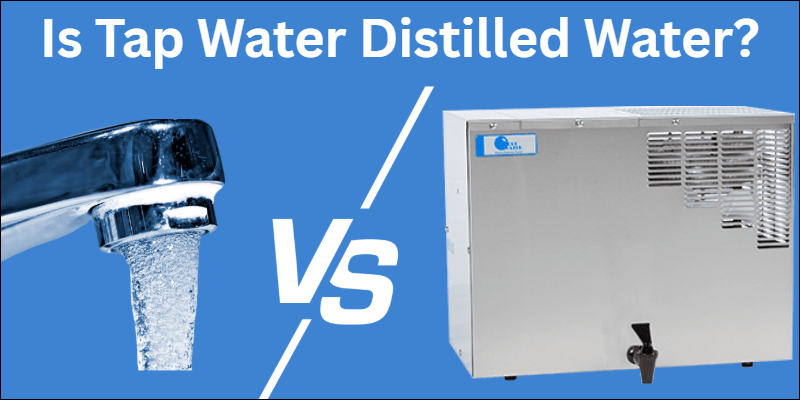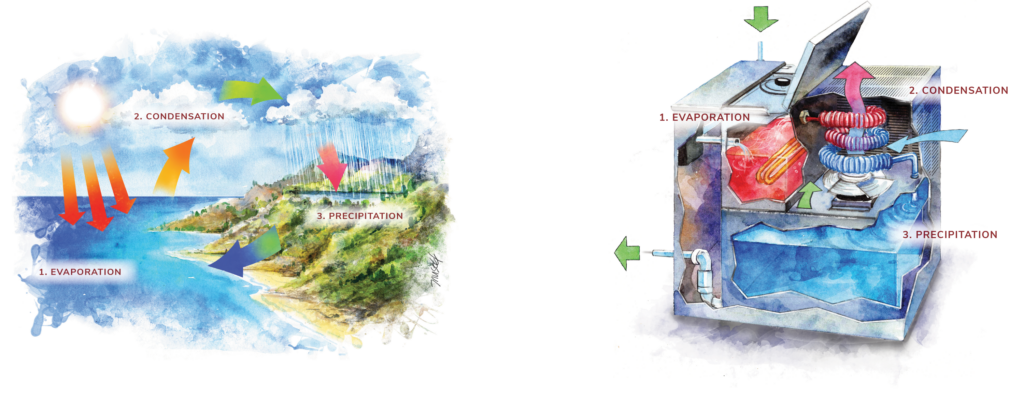Tap Water is Not Distilled Water
No, tap water is not distilled water. Tap water comes from municipal water supplies and, while treated for safety, it still contains a variety of dissolved minerals, chemicals, and potential contaminants depending on the source and treatment process. Distilled water, on the other hand, is purified through distillation—a process that involves boiling water to produce steam, then condensing that steam back into liquid form, leaving impurities behind. The result is a highly purified form of water that lacks nearly all dissolved solids, contaminants, and minerals. While both are forms of drinking water, they are fundamentally different in purity and composition.
What is Tap Water?
Tap water is the water that flows from your faucets at home, provided by public water systems or, in some rural areas, private wells. In the United States, the vast majority of people rely on public municipal water systems. These systems draw water from natural sources such as rivers, lakes, or underground aquifers. Before reaching your home, the water goes through several treatment steps, which can include coagulation, sedimentation, filtration, and disinfection (commonly with chlorine or chloramine). These steps are designed to remove or neutralize biological contaminants like bacteria and viruses, and to reduce certain chemical pollutants.
The composition of tap water can vary significantly based on its source and the treatment practices used by the local utility. Some tap water contains naturally occurring minerals like calcium and magnesium, which contribute to water “hardness.” Others may have residual chemicals used during the disinfection process, or trace amounts of heavy metals that leach from aging infrastructure. Despite these variations, tap water in most parts of the country is considered safe to drink under federal and state guidelines.
Tap Water Quality in the USA
Tap water quality in the United States is regulated by the Environmental Protection Agency (EPA) under the Safe Drinking Water Act (SDWA). This law mandates that public water systems test for and treat more than 90 contaminants, including bacteria, lead, nitrates, and various chemicals. Utilities must report these results annually to consumers in the form of a Consumer Confidence Report (CCR).
However, despite this regulatory oversight, recent news stories have highlighted growing concerns about the consistency and safety of tap water across different communities. One of the most well-known crises occurred in Flint, Michigan, where lead contamination due to a change in water supply and lack of corrosion control exposed thousands of residents to dangerous levels of the metal. More recently, attention has turned toward per- and polyfluoroalkyl substances (PFAS), also known as “forever chemicals,” which have been detected in water supplies across multiple states. These man-made chemicals are linked to cancer and other health issues and are notoriously difficult to remove from water using standard municipal treatment processes.
In some rural areas, water systems are underfunded and aging, making it difficult to consistently meet EPA standards. According to a 2021 analysis by the Natural Resources Defense Council (NRDC), over 25 million Americans are served by water systems that violate health-based quality standards.
Still, it’s important to recognize that the majority of municipal water systems in the U.S. deliver water that meets federal and state safety regulations. These systems are required to undergo frequent testing and disclose any violations. In most urban areas, tap water is routinely tested and treated to be safe for consumption. However, the presence of even trace amounts of contaminants, combined with growing public awareness and media scrutiny, has led many people to question whether “safe” is the same as “pure.”
What is Distilled Water?
Distilled water is water that has been purified using the process of distillation. In this method, water is heated until it boils and turns into steam. The steam rises and is then captured in a separate chamber, where it cools and condenses back into liquid water. Since most impurities, such as salts, minerals, heavy metals, and microorganisms, do not vaporize with the water, they are left behind in the original container. The resulting liquid is essentially pure H₂O, free from nearly all contaminants and dissolved substances.
Distillation has been used for centuries, and it remains one of the most effective methods of water purification. It’s especially useful in settings where ultra-pure water is required, such as in laboratories, medical facilities, or certain industrial processes. Because it removes not only pathogens but also a wide range of chemical contaminants, distilled water is sometimes preferred for sensitive uses like filling CPAP machines, laboratory equipment, or for use in autoclaves and medical sterilization. Distilled water is also used by individuals with particular health concerns or in homes where water quality is compromised.
How is Tap Water Different from Distilled Water?
The primary difference between tap water and distilled water is the level of purity. Tap water, even when treated, contains trace amounts of minerals, disinfectants like chlorine, and possibly other impurities depending on the local water source and infrastructure. In contrast, distilled water has nearly all of these substances removed.
Another key distinction is how each type of water is processed. Tap water is filtered and chemically treated to eliminate pathogens and meet safety guidelines, but the treatment is not designed to remove every contaminant. For instance, many municipal systems do not filter out PFAS, pharmaceuticals, or microplastics effectively. Distillation, by boiling water into vapor and condensing it, leaves behind almost all inorganic compounds, metals, and many chemicals.
Taste is another noticeable difference. Tap water can have flavor from its mineral content or disinfection chemicals, while distilled water tends to taste neutral because it is only pure H2O. Some people may find tap water tastes fine to them while others prefer the “clean” taste of distilled water. It is especially useful and recommended for baby formula preparation.
Additionally, while tap water is readily available while distilled water must be either purchased or produced using a home water distiller. Most people who purchase a home water distiller believe that there’s a compelling health or quality reason to use it regularly.
Reasons to Purify Tap Water
Even though most tap water in the U.S. meets basic safety standards, many people choose to further purify their water to remove contaminants that may still be present. Here are several common reasons to purify tap water:
1. Remove Chlorine and Chemical Byproducts
Municipal water systems commonly use chlorine or chloramine to disinfect water. While effective, these chemicals can leave behind byproducts like trihalomethanes (THMs), which are linked to health concerns over long-term exposure. Home purification systems or distillation can remove these substances.
2. Reduce Heavy Metals
Aging pipes and infrastructure can leach metals like lead, copper, or iron into tap water, especially in older homes. While these contaminants may not be present in high levels everywhere, even small amounts can pose a risk, particularly for children and pregnant women.
3. Eliminate PFAS and Other Industrial Contaminants
As scientific awareness increases around PFAS, more consumers are seeking ways to remove them from their drinking water. Activated carbon filters and reverse osmosis systems are effective for PFAS removal, but distillation is also highly effective since PFAS do not vaporize easily.
4. Address Microorganisms in Well Water
Private well users are responsible for testing and treating their own water. Unlike municipal systems, wells can be more vulnerable to bacterial contamination or runoff from agricultural chemicals. Distillation offers a reliable way to ensure biological safety.
5. Improve Taste and Odor
Some tap water has an unpleasant taste or odor due to high mineral content, chlorine, or sulfur compounds. Purification methods, including distillation, can improve both flavor and smell, making water more enjoyable to drink and cook with.
6. Peace of Mind
For people with compromised immune systems, the elderly, infants, or those recovering from illness, purified water can offer extra reassurance. It’s also appealing to health-conscious individuals who want full control over what they consume.
Home Water Distiller Basement Installation Option
Tap Water is Not the Same as Distilled Water
Tap water is not the same as distilled water. Tap water is treated by municipalities to meet health and safety standards, but it still contains minerals, disinfection chemicals, and potentially trace levels of contaminants. It’s believed to be safe to drink and is regulated by the government, but recent news about lead, PFAS, and other pollutants has raised valid concerns among consumers.
Distilled water, by contrast, undergoes a rigorous purification process that removes nearly all impurities, making it one of the purest forms of water available. It’s ideal for applications where contaminant-free water is preferred.
Understanding the differences between tap and distilled water helps consumers make informed decisions about their water sources. Whether motivated by taste, health, or specific use cases, many people opt to purify their tap water at home—through distillation, filtration, or other methods—as a way to ensure peace of mind and maximize water quality.










